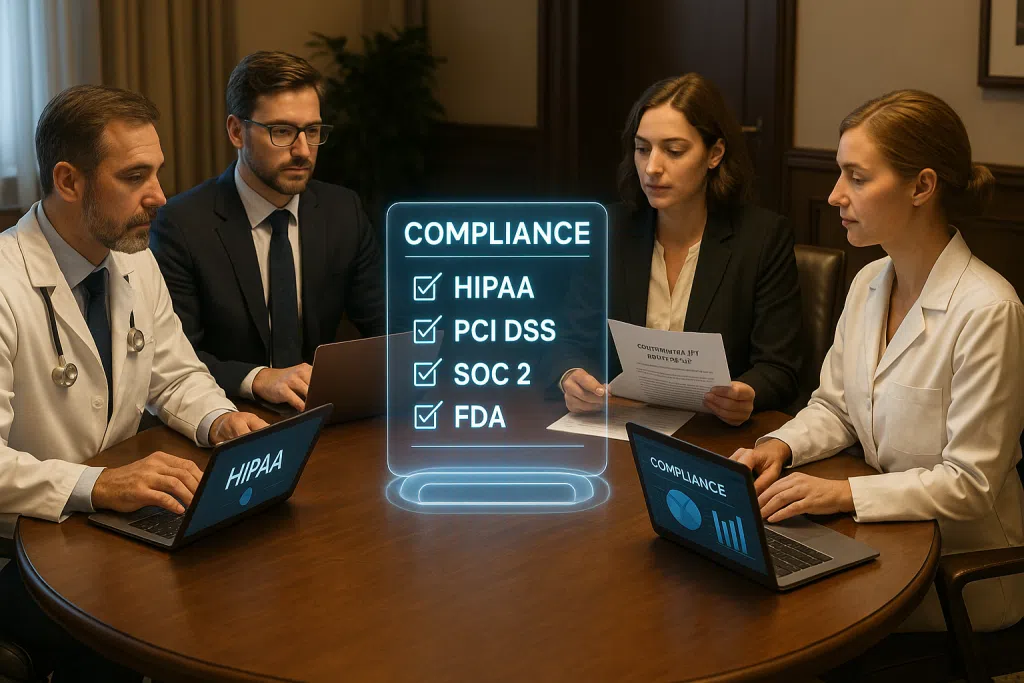Navigating the complexities of regulatory requirements can be overwhelming for small and mid-sized organizations, especially in highly regulated sectors like healthcare, finance, legal, and pharmaceuticals. A robust regulatory compliance checklist not only helps your business avoid costly fines, reputational damage, and disruptions, but it also instills trust in your clients and stakeholders. This article delivers a detailed, actionable guide designed for leaders and IT professionals seeking to build, implement, or improve their organization’s compliance practices with a strong focus on cybersecurity compliance and data security. If you want clarity, confidence, and actionable steps, follow along.
If you’re ready to take the next step, book an initial discovery meeting with a compliance technology expert at Blueclone Networks.
Understanding Regulatory Compliance in a Digital World
Adhering to evolving regulations isn’t a simple box-ticking exercise. Today, many organizations in healthcare, finance, legal, and pharmaceutical sectors face a rapidly growing patchwork of laws, such as HIPAA, HITECH, PCI-DSS, FINRA, SOX, and GDPR. Each introduces specific requirements for managing, processing, and securing sensitive data. At the same time, technology disruptions, cloud computing, remote work, and artificial intelligence force businesses to update their practices to reduce risk and satisfy regulators.
What does a regulatory compliance checklist mean in practice? Unlike a generic security assessment, a compliance checklist should map to the frameworks and standards your business is legally bound to follow. For example, healthcare organizations in New Jersey must strictly comply with HIPAA, state privacy acts, and HITECH mandates. Law firms in Princeton may need to satisfy both state bar requirements and overarching data protection laws. Local finance and pharmaceutical SMBs often juggle federal standards alongside strict client contractual requirements.
Why does this matter? A modern regulatory compliance checklist operates as an organized roadmap, ensuring no step is missed. Beyond safeguarding information, it’s about enabling business continuity and customer confidence. Missing even a minor requirement could break trust or trigger audits and penalties.
Clarifying the difference between cybersecurity compliance and general IT security is also essential. Cybersecurity compliance demands that technology, process, and organizational controls are aligned not just for general IT best practices but according to specific legal regulations. This applies to everything from how data is encrypted and who can access it, to incident response and documentation practices. For organizations with IT teams stretched thin or without a full-time compliance officer, a well-crafted checklist supported by seasoned experts (like Blueclone Networks’ local specialists) is an absolute necessity.
Book a personalized compliance review and harness expert guidance. book an initial discovery meeting with Blueclone Networks to start building your compliance readiness today.
Building a Regulatory Compliance Checklist: The Key Components
A comprehensive regulatory compliance checklist is never static. It must adapt to new regulations, industry guidance, and business changes. To serve the needs of SMBs in regulated industries, this section breaks down the must-have components of a compliance checklist and explains how each aligns with state, federal, and industry standards.
Risk Assessment and Gap Analysis
The foundation of compliance is understanding where you stand today. Begin with a structured risk assessment. This identifies and evaluates threats to sensitive data, from cyberattacks and insider misuse to physical disasters or infrastructure failures. A gap analysis compares your existing controls to the specific requirements of regulations like HIPAA, PCI-DSS, or SOX.
Tip: Use reputable third-party frameworks like NIST CSF or CIS Controls as a cross-reference for your data security checklist. This provides universal touchpoints while adapting to specific regulations.
Data Inventory & Classification
You can’t protect what you don’t know you have. Catalog all sensitive data, health records, financial transactions, legal documents, and personal identifiers. Classify data based on importance, regulatory requirement, and risk category (public, internal, confidential, or restricted). This will drive both security protocols and access control decisions.
Example: A healthcare SMB storing ePHI (electronic Protected Health Information) for patients in Central NJ must identify every system, location, and person who interacts with that data to stay compliant.
Access Control and Authentication
Regulations universally demand restricting sensitive information to authorized individuals. Your compliance checklist should mandate multi-factor authentication (MFA), role-based access controls (RBAC), regular privilege reviews, and clear procedures for employee onboarding/offboarding.
Best Practice: Align authentication with zero-trust security principles, which limit lateral movement within your network. This reduces the blast radius of an insider threat or compromised credential.
Written Policies and Procedures
Auditors and regulators expect clear, up-to-date documentation on how you safeguard data and respond to incidents. This includes privacy policies, information security programs, data retention schedules, incident response plans, and acceptable use policies. Documentation should be reviewed annually or whenever regulations change.
Security Awareness Training
Employee errors remain a top cause of data breaches. HIPAA, PCI, and FINRA require regular staff training on data protection, common attack vectors (like phishing), and how to report security incidents. Make training interactive and industry-specific for maximum impact.
Technical Safeguards and Cybersecurity Controls
Security measures like firewall protection, endpoint security (EDR), encrypted backups, secure email gateways, intrusion detection, and patch management systems are baseline requirements. For organizations in NJ and surrounding areas, deploying controls that match cloud, on-premise, and hybrid infrastructure is crucial.
Vendor and Third-Party Management
If your business shares data with outside providers (cloud vendors, SaaS apps, billing services), it’s essential to document due diligence and ongoing monitoring of those third parties. Many data breaches trace to insecure vendor connections. Regulators often require evidence of ongoing risk management and regular reviews of vendor compliance status.
Incident Response and Breach Notification
Every regulated organization must be prepared for the worst. Your regulatory compliance checklist should define how to detect, respond to, and escalate security incidents. Draft a breach notification policy that specifies timeframes and authorities for reporting (HIPAA requires notification within 60 days, for example).
Regular Testing, Audits, and Continuous Monitoring
Static compliance is a myth. Schedule and document regular penetration tests, vulnerability scans, email security audits, and tabletop exercises. Logging and monitoring key systems for suspicious activity aligns with all major regulations.
To really understand how each item on this checklist translates from theory into everyday operations, consider recent industry studies and enforcement actions as referenced by the U.S. Department of Health & Human Services and Federal Trade Commission Compliance Resources (2024).
Building your checklist is only the first step. Ensuring it is both practical and up-to-date demands attention, and often, external expertise. Remember, compliance is not a one-off technical project, but a continual business function that should grow with you as risk landscapes evolve.
How to Put Your Regulatory Compliance Checklist into Action
Setting up a checklist is essential, but achieving full compliance takes commitment, communication, and disciplined action across every department. Here’s a step-by-step guide to implementing your compliance plan, plus a real-world example of how coordinated execution protects your organization.
Step 1: Set Leadership Involvement and Ownership
Every compliance program needs clear executive sponsorship, such as a Compliance Officer, CIO/CTO, or dedicated manager. For in-house IT teams or co-managed environments in New Jersey SMBs, ensure there’s a single point of accountability to drive the process and report progress.
Step 2: Communicate Checklist Expectations Across Teams
Break down complex requirements into plain-language tasks for every department. Use a cross-functional approach that involves HR, legal, IT, and operations. This ensures nothing falls through the cracks, especially when regulations intersect (for example: HIPAA and PCI requirements for healthcare providers who process credit card payments).
Step 3: Customize and Distribute the Data Security Checklist
Do not simply rely on an off-the-shelf cybersecurity checklist. Customize each control for your unique workflow, information systems, and physical environment. For law firms, this might include strict mobile device management policies; for healthcare clinics, the focus may be on EMR/EHR access controls.
Step 4: Train and Simulate
Practical training beats generic presentations. Run simulated phishing campaigns, test your incident response plan with tabletop exercises, and conduct periodic awareness refreshers. Document participation and use test results to refine future policies.
Step 5: Track Progress and Document Remediation
Maintain a living document showing the status of each item on your regulatory compliance checklist. Where gaps are identified, assign owners and deadlines for remediation. This audit log is vital should regulators or auditors request proof of your due diligence.
Step 6: Review, Test, and Improve
Schedule an annual full-scale review of all compliance activities. After incidents, policy changes, or major business updates, run targeted check-ins, often these are required by law (for example, after a third-party vendor breach).
Example in Practice: A Princeton-based financial services firm partnered with Blueclone Networks to implement a new cybersecurity compliance program. After customizing their compliance checklist, Blueclone helped run penetration tests, uncovered an outdated firewall, deployed a SASE with Lan Zero Trust, and implemented staff training. The firm not only passed a subsequent FINRA audit but also avoided a costly ransomware attack, thanks to robust backup and incident response plans outlined in their checklist.
A successful compliance program transforms checklists into habits, and ensures nothing gets missed as your organization grows or regulations shift.
For hands-on guidance, policy templates, and practical rollout support, book an initial discovery meeting with Blueclone Networks’ compliance experts.
Integrating Cybersecurity and Data Security into Your Compliance Approach
While achieving compliance is critical, regulators increasingly expect that your technical defenses meet or exceed baseline standards. Traditional checklists must be paired with actionable cybersecurity controls, blending IT best practices with industry-specific regulations.
Incorporating a Cybersecurity Compliance Framework
Adopt a recognized cybersecurity framework (NIST CSF, ISO 27001, CIS Controls) as the architecture for your security program. Many New Jersey businesses map their regulatory compliance checklist against NIST or CIS for both federal/state audits and client contract requirements.
A robust cybersecurity checklist, tied to regulatory demands, includes:
- Current patch management and vulnerability scanning schedules
- Endpoint Detection and Response (EDR) deployment on all devices
- Email filtering with targeted threat protection
- Data encryption (at rest and in transit)
- Enforced MFA across cloud and on-premise systems
- Routine reviews of access logs and administrative activity
Tip: The CIS Controls v8 Cybersecurity Checklist is a publicly available resource that aligns with many compliance mandates, especially for healthcare and finance.
Marrying Regulatory and Data Security Checklists for Maximum Effectiveness
Compliance rules specify what must be protected, but a data security checklist determines how systems are hardened against real-world threats. This means layering access controls, monitoring, and strong authentication on top of documented policies. While a law firm might focus on document encryption and email archiving, a healthcare provider would deploy strict controls to segment EMR records, satisfying both HIPAA and cybersecurity requirements.
Testing and Automation, Keeping Ahead of Breaches
Regulations frequently require annual testing, but more frequent automated scans, penetration tests, and remediation tracking help organizations catch threats before they escalate. Automated compliance monitoring tools are invaluable for SMBs without large internal teams, flagging gaps and generating audit-ready reports.
Consider deploying specialized tools for:
- Automatic policy enforcement (password complexity, device encryption)
- Detection of unauthorized access to confidential data
- Ongoing review of firewall and intrusion detection system configurations
- Scheduled backups with automated recovery tests
Ongoing Threat Awareness
Threat landscapes are evolving faster than ever, with ransomware, phishing, and supply-chain attacks on the rise. By embedding security expertise into checklist reviews and involving trusted partners for tabletop exercises or third-party audits, SMBs remain prepared, not just compliant.
Regulatory Compliance Checklist Templates for SMBs
To translate guidance into immediate action, this section lays out sample templates tailored for SMBs in regulated industries. These templates offer practical starting points for creating an effective compliance program, and should be adapted to the specific standards your organization faces.
General Regulatory Compliance Checklist
Determine Applicable Regulations
- HIPAA, PCI-DSS, SOX, GLBA, GDPR, FINRA, HITECH, and state/local mandates
Conduct Initial Risk Assessment
- Identify potential vulnerabilities and risks (digital, physical, and people-related)
Map and Classify Sensitive Data
- Document where data lives, how it flows, and its risk classification
Develop and Approve Clear Policies
- Information security, privacy, retention, incident response, access, acceptable use
Control Data Access and Monitor Usage
- Enforce role-based restrictions, MFA, access logs, and periodic reviews
Implement Physical and Network Security
- Secure devices, oversee physical facility access, segment networks, and update firewalls
Deliver Security Awareness Training
- Run onboarding, annual refreshers, and targeted campaigns (phishing, social engineering)
Vet Vendors with Due Diligence
- Demand secure contracts, regular risk reviews, and proof of third-party compliance measures
Develop an Incident Response Playbook
- Document notification timelines, staff responsibilities, and reporting channels
Schedule Regular Testing and Audits
- Annual penetration testing, vulnerability management, compliance reviews
Healthcare-Specific Data Security Checklist (HIPAA & HITECH)
- Designate a HIPAA Security Officer
- Document ePHI inventory and locations
- Perform and log regular HIPAA Security Rule audits
- Encrypt all mobile and endpoint devices containing ePHI
- Implement secure user authentication for EMRs/EHRs
- Enforce unique user IDs and remove or update orphaned accounts
- Review and update Business Associate Agreements (BAAs)
- Enable logging of all access to ePHI and review logs regularly
- Deliver annual HIPAA security and privacy training
Finance/Legal/Pharma Cybersecurity Checklist
- Designate a Compliance Officer (SOX, FINRA, GLBA, etc.)
- Protect confidential and client data with approved encryption
- Enforce strict password policies and MFA
- Segment critical databases from general networks using VLANs or firewalls
- Vet and monitor all third-party vendors for data-sharing agreements
- Back up all data offsite with encrypted, tested recovery points
- Maintain documented cybersecurity incident response plans
- Test disaster recovery at least annually
These checklist templates offer a springboard, but real compliance demands adaptation and ongoing oversight. Experienced IT partners like Blueclone Networks help ensure checklists evolve alongside regulations, threats, and business expansion.
Mid-article CTA: Ready to assess your status and implement an effective compliance checklist tailored for your industry? book an initial discovery meeting to get actionable next steps.
Common Regulatory Compliance Challenges and Practical Solutions
Even the most sophisticated organizations can run into recurring hurdles when pursuing compliance. Understanding these challenges and how to overcome them will help your business stay audit-ready, reduce costs, and minimize disruptions.
Challenge 1: Navigating Multiple Overlapping Regulations
Small and mid-sized firms in New Jersey and similar regions often face the challenge of overlapping rules (for example, HIPAA for patient data, PCI for payment details, and local privacy laws). The solution is mapping a core set of safeguards, like least-privilege access and strong encryption, against all standards. This approach minimizes redundant work while hitting every regulatory target.
Challenge 2: Keeping Policies Up-to-Date
Regulations and threats change quickly, but many businesses let their policies lapse. Setting quarterly policy reviews, leveraging automated compliance management systems, and assigning a policy owner ensure that documents remain current and accurate.
Challenge 3: Managing Remote and Hybrid Workforces
Remote work expands risk. Be sure your regulatory compliance checklist covers security for home offices, remote access, and mobile devices. Require VPN use, encrypt all portable devices, and train staff to spot threats outside the office.
Challenge 4: Vendor and Third-Party Risks
Third parties frequently introduce vulnerabilities. Ensure your checklist covers due diligence, ongoing risk monitoring, and contract clauses requiring security standards. Run annual reviews to catch changes in vendor practices.
Challenge 5: Resource and Expertise Gaps
With limited resources, SMBs may not have in-house compliance or cybersecurity teams. Address this gap by partnering with a specialized IT services provider, bringing both regulatory and technical expertise to the table. Providers like Blueclone Networks can support everything from risk assessments to vendor management, ongoing monitoring, and rapid incident response.
According to HealthITSecurity’s 2024 Breach Report, SMBs that pair external expertise with a solid, actionable checklist experience fewer audit failures and recover faster from incidents than peers relying solely on internal resources.
Frequently Asked Questions: Regulatory Compliance Checklists
A cybersecurity checklist focuses on technical defenses (such as firewalls, encryption, and endpoint protection) to safeguard IT environments from attacks. A regulatory compliance checklist, on the other hand, ensures that all legal, regulatory, and contractual obligations related to data privacy, documentation, access management, and reporting are met. The strongest programs integrate both types to safeguard sensitive information and avoid fines.
Ultimate accountability lies with executive leadership, but day-to-day management may be handled by a compliance officer, IT manager, or even outsourced partners. Responsibility should be clearly assigned to ensure policies are enforced, training is delivered, and gaps are promptly addressed.
At a minimum, the checklist should be reviewed and updated annually. However, it’s wise to update after major regulatory changes, new technology deployments, cybersecurity incidents, or business expansions.
Non-compliance can lead to steep fines, legal action, loss of business licenses, reputational harm, and loss of client trust. Some regulations (like HIPAA) also include mandatory public breach disclosures and possible criminal penalties for willful neglect.
Yes. Partnering with a managed IT or co-managed IT provider brings immediate expertise, up-to-date tools, and proactive compliance support, minimizing risk, reducing the internal workload, and allowing your team to focus on core business activities while staying audit-ready.





